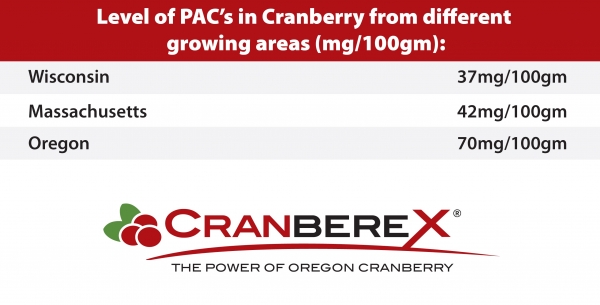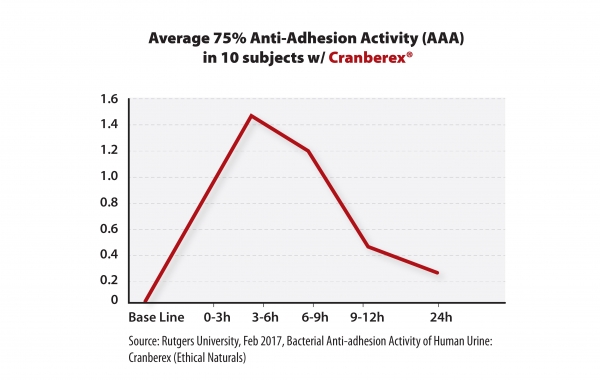Promotional Features
Cranberex brings the power of cranberry's A-type proanthocyanidins from the Oregon Coast
'From Field to Finished Product' was one of the first statements that Ethical Naturals (ENI) created and registered as a company trademark over 18 years ago.
It reflected its ongoing commitment to know and understand the path that each botanical ingredient takes from where it is grown, through extraction and processing, to its final stage in the hands of the consumer.
ENI's Cranberex cranberry extract most clearly reflects this commitment to traceability. For this product, ENI works closely with a few family farmers on the Oregon Coast where the premium cranberries for its extract are grown. In this way, it obtains the best fruit at the optimal time in the harvest season.
After harvest, the berries for Cranberex go to one of the most advanced extraction facilities in the world. Here the extract is made from the whole berry, rather than from juice or pomace that is used for many cranberry products. This whole berry source is another reason for the consistent, high-level concentration of the naturally occurring active constituents.
The very dark red Cranberex extract is standardized to 15%, the most active A-type PACs (tested by AOAC-DMAC method), and also other PACs naturally occurring in cranberry. As a final step Cranberex is tested through the internal quality control lab of ENI a Current Good Manufacturing Practice (cGMP-certified facility by the National Sanitation Foundation, NSF), and independent laboratories (ISO 17025 accredited) in the US and supplied to customers through ENI’s distribution facility in Redwood City, California.
Oregon supplies 4-5% of the US cranberry harvest
The US cranberry harvest totaled 403,000 tons in 2022 and 85-90% of this was produced in the Northeast states, primarily Wisconsin and Massachusetts. However about 4% of this supply comes from small farms on the Oregon coast where the cool and misty Pacific breezes help to produce cranberries that have special qualities for creating extracts with high levels of A-type PACs.
Below is a chart that shows comparative levels of these PACs from different production areas.
A-type PACs: The key to cranberry's UTH benefits
That cranberries have benefits in supporting urinary tract health (UTH) has been known for many years. However, only recently has the source of this activity been linked to cranberry's unique A-type PACs.
The key clinical study, 'A-type cranberry proanthocyanidins and uropathogenic bacterial anti-adhesion activity', published in 2005, was a turning point in the understanding how cranberries supported UTH.1
Prior to this study, clinical and epidemiological studies supported the role of cranberry (Vaccinium macrocarpon) in maintaining urinary tract health through a process of Anti-Adhesion Activity (AAA) whereby the E.coli bacteria that cause urinary tract infections (UTIs) are prevented from adhering to the urinary tract.
However, compounds responsible for these benefits were little understood. All fruits and berries, including cranberries, contain a wide range of PACs in their dark colored pigments. These compounds also play important roles as immune enhancers, in anti-inflammatory activity, cardiovascular support and many other health functions, but play no active role in supporting UTH through AAA.2
However, in the 2005 study Howell et al showed clearly that the A-type PACs found only in cranberry were responsible for its anti-adhesion activity. It's for this reason that Cranberex and other high-grade cranberry extracts are tested by the DMAC method that quantifies levels of the specific A-type PACs.
Since this key study, additional clinical trials have clearly confirmed the AAA of A-type PACs and established effective dosage levels of 36-72mg per 24 hours. One of these studies performed by Rutgers University in 2017 with ENI's Cranberex extract clearly affirmed this bacterial anti-adhesion effect based upon a 36mg dosage for up to 12 hours.3
How clinically effective dosages are achieved in Cranberex
Though cranberries contain a wide range of PACs, the A-type PACs only amount to a very small percentage generally about 70mg per 100g in Oregon sourced cranberry. Thus, very high concentrations and sophisticated extraction methods are required to achieve the effective dosage levels. This is one reason why many cranberry extracts do not contain, or claim to contain, these levels of A-type PACs but are often standardized for total PAC levels by different test methods that appear to give much higher results.
Cranberex is standardized to contain 15% A-type PACs as measured by the DMAC method that is considered to be the most accurate method available for this complex component and has been endorsed by a number of associations, including the United States Department of Agriculture (USDA), Rutgers University, and The Cranberry Institute. It was also used for validating cranberry UTI claims in the EU.4
The significance of cranberry's Anti-Adhesion Activity
UTIs today account for at least eight million visits to healthcare facilities in the US per year and antibiotic resistance to these infections is becoming an increasing problem.5 Because cranberry's AAA does not kill bacteria, but prevents adhesion to the urinary tract, bacteria do not acquire antibiotic resistance. For this reason, high-grade cranberry extracts, tested and standardized for the active A-type PACs, can play an increasingly important role in supporting UTH in the US and around the world.
References
1. Howell, A. B.; Reed, J. D.; Krueger, C. G.; et al. (2005). A-type cranberry proanthocyanidins and uropathogenic bacterial anti-adhesion activity. Phytochemistry, 66(18), 2281–2291.
2. Zafra-Stone, S.; Taharat, Y.; Bagchi, M.; et al. (2007). Berry Anthocyanins as novel antioxidant in human health and disease prevention. Mol. Nutr. Food Res. 51, 675 – 683.
3. Rutgers University. (2017). Bacterial Anti-adhesion Activity of Human Urine: Cranberex (Ethical Naturals). Unpublished ex-vivo study report.
4. American Herbal Pharmacopoeia and Therapeutic Compendium (2016). Cranberry Fruit, Vaccinium macrocarpon Aiton, Revision. Page 15.
5. Ku., J. H.; Bruxvoort, K. J.; Salas, S. B.; et al. (2023). Multidrug Resistance of Escherichia coli From Outpatient Uncomplicated Urinary Tract Infections in a Large United States Integrated Healthcare Organization. Open Forum Infectious Diseases, 10 (7).






